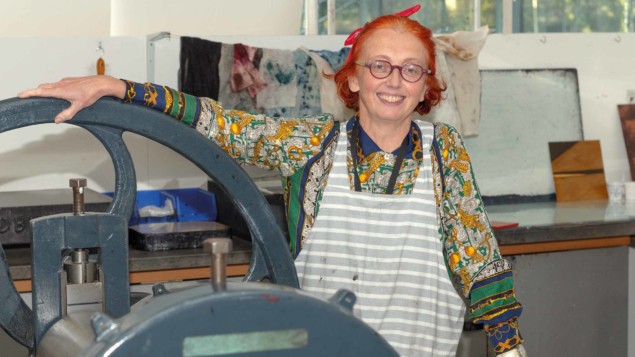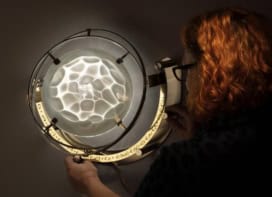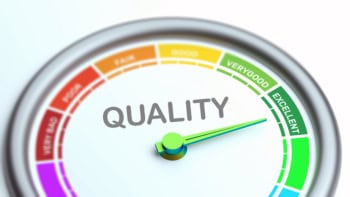How does an industrial physicist end up in an arts faculty working on historic printing processes – and why? Susanne Klein tells Joe McEntee all about it

Back when the 18-year-old Susanne Klein was considering her subject options for university, friends and family assumed that it was a straightforward pick between a degree in law (her father was a barrister) or German literature (her strongest subject at school). It turns out they were half-right. Klein did indeed face a binary choice – just not the one that everyone had anticipated. “When I went to register at university, I wasn’t sure whether to opt for German literature or physics,” she explains. “I flipped a coin, that’s literally how I decided, and once it landed for physics I figured why not – this will be much more of a challenge. I’ve never looked back.”
Since then, it’s fair to say that Klein has made a point of defying convention. In her student days, she admits to being driven to succeed, at least in part, by the somewhat unenlightened guidance of one physics professor. “He actually said to me ‘physics is not for girls, you are on the wrong course’,” she explains. “I thought to myself: ‘you old bastard – I’ll show you’!”
Spurred on, Klein has taken the path less travelled as a professional physicist, pushing and crossing boundaries between industry and academia, theoretical and experimental research, as well as her homeland in Germany and adopted home in the UK – long before Brexit was even a word. In her latest incarnation, Klein finds herself at another interface – this time between art and science – as an Engineering and Physical Sciences Research Council (EPSRC) manufacturing fellow in the Centre for Fine Print Research at the University of the West of England (UWE) in Bristol.
Art for art’s sake
Based in the UWE arts faculty, the fellowship sees Klein heading up a five-year project (2018–2023), funded to the tune of £1.2 million, with the goal of reimagining two 19th-century printing processes – Woodburytype and Lippmann photography. These historic technologies have been largely forgotten as they were not commercially competitive, despite the fact that they produce prints far superior to anything available today. “My task is to find out how they did it and then give these processes a 21st-century makeover so that they are cheaper, faster and more accessible,” Klein explains.
That makeover seeks to exploit Klein’s diverse research experience – spanning colloidal chemistry, optics and 3D printing – as well as an extensive network of industry and academic contacts developed over two decades working as a senior scientist at Hewlett-Packard (HP). If she and her team are successful, the resulting high-quality, continuous-tone printing processes will likely find a range of high-end commercial applications: from original works of art and designer fashion to the packaging of luxury goods and unhackable anticounterfeiting for pharmaceuticals and credit cards.
So what’s life like working as a scientist surrounded by artists? Klein sees a lot of hands-on knowledge, craftsmanship and deep understanding among her UWE colleagues, adding that “people are very generous with that knowledge”. However, boundaries remain between the two cultures. “Science is almost forgotten in art,” she says. “There is a real block, in the sense that a lot of people who study art hated science in school.”
For Klein, though, this feels like an opportunity. By helping arts students and researchers to understand the science better, she reasons, it should be possible for them to deliver better outcomes in their art. “If you know how to make your inks and how colour is generated, for example, you don’t need to experiment so much – there is less trial and error.”
Industry insights
Klein’s current research post at UWE is no outlier. Throughout her career, she has sought new research directions on a regular basis. A PhD in theoretical physics – which focused on analytical methods for treatment planning in radiation therapy – was followed by a stint at Deutsche Telekom, Germany’s biggest telecommunications company, where she worked on next-generation optical switching technologies for fibre-optic networks. Then came the move to the UK – permanent as it turns out – as a Royal Society research associate, working on theoretical and experimental aspects of classical optics in Michael Berry’s group at the University of Bristol.
For the most part, though, Klein’s “scientific DNA” has been shaped by the time she spent as an industrial R&D scientist at HP Labs in Bristol. Her unwillingness to be typecast was evident – in fact encouraged – at HP, where her research programme spanned from liquid crystals and advanced display materials, through 3D printing technologies to optical cryptography.
That adaptability and openness to new research pathways holds a lesson for early-career scientists, says Klein. “Physics can come across as a dull, secret society – an unattractive choice for free spirits who want to be creative. I try to show young people that physics is something exciting, collaborative, an adventure. You just have to dare.”
I try to show young people that physics is something exciting, collaborative, an adventure
Having crossed from academia to industry and back again on several occasions, Klein is well placed to advise on what it takes to prosper on both sides of the fence. Money, of course, is right up there. “At HP, as long as you sold your project to the company you were never short of money for your R&D,” Klein explains. “And I was a good seller of the science, both within HP as well as to the customers.”
Put another way, successful science is not just about the results, it’s the story you tell about those results – and telling that story with passion, energy and enthusiasm. “You have to be a good entertainer and be remembered as a person who is really connected with the science,” Klein adds. “If you just show your results, the audience will fall asleep and you will be forgotten.”
For Klein, that passion for science (and art) remains as strong as ever – perhaps not surprising given that the EPSRC fellowship is very much her dream job. “The environment at UWE suits my personality and approach. I can spread my wings,” she concludes. “You can apply your ideas directly and quickly here. I also get to be more eccentric and no-one notices.”
Susanne Klein in brief
Things she does when not doing science: taekwondo (Klein is a black belt, 3rd dan) and mountain biking (she ran all-female group in Gloucestershire for several years, exasperated by the macho male mountain-biking culture)
Three “must-haves” for a desert island: book – The Long Ships: a Saga of the Viking Age by Frans Bengtsson; music – Seasick Steve; possession – Swiss army knife
On women in physics: “I don’t want to tell young women it’s easy. When you go into physics there’s no red carpet – you have to fight for it. If you know that, and you’re ready for it, then it’s no problem.”
On optimism: “When I was young, I thought we’d have a world revolution, and everyone would be equal by the time I was grown up. Well I’m still waiting!”



